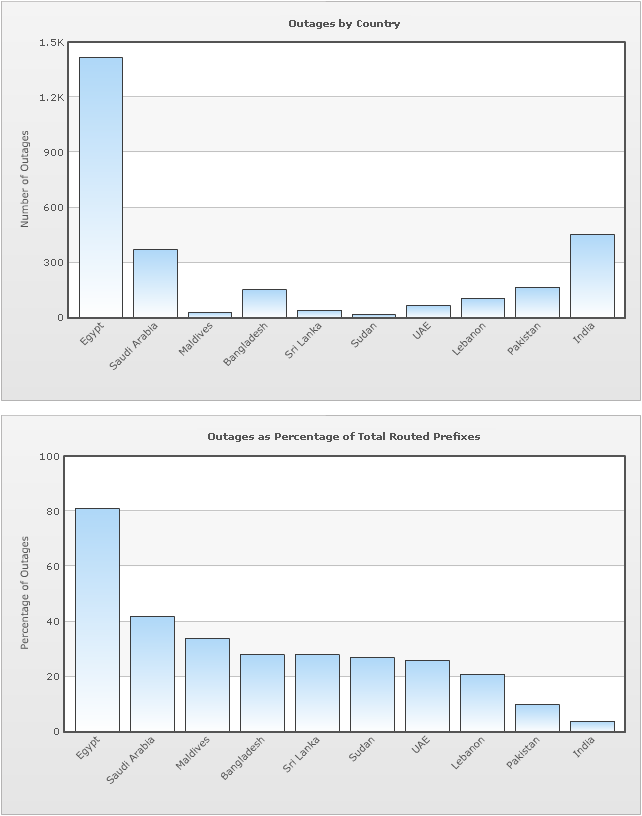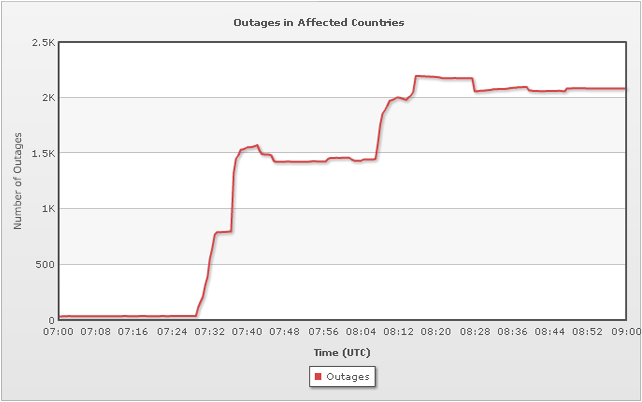
|
||
The end of the year is approaching which seems to be a harbinger of Internet disasters. Four years ago (on 24 Dec. 2004), TTNet significantly disrupted Internet traffic by leaking over 100,000 networks that were globally routed for about an hour. Two years ago (on 26 Dec. 2006), large earthquakes hit the Luzon Strait, south of Taiwan, severing several underwater cables and wreaking havoc on communications in the region. Last year there was a small delay. On 30 Jan. 2008, more underwater cables were severed in the Mediterranean, severely disrupting communications in the Middle East, Africa, and the Indian subcontinent.
Calamity returned to its customary end-of-year schedule this year, when early today (19 Dec. 2008) several communications cables were severed, affecting traffic in the Middle East and Indian subcontinent. According to a press release by France Telecom three major cables were damaged: Sea-Me-We 4 at 7:28 UTC, Sea-Me-We 3 at 7:33 UTC, and FLAG FEA at 8:06 UTC. It appears that the SMW3 cable was only partially cut, the SMW4 cable was completely cut, while the FLAG cable was “observed down” with no other information given. The location of the cut appears to be between Sicily and Tunisia in a section which is the responsibility of Egypt Telecom. The causes of the cut remained unclear. It seems that ships were deployed to repair the damaged cables, but no ETA was given.
In this preliminary analysis we considered prefixes (networks) that suffered outages between 07:00 UTC and 17:00 UTC on 19 Dec. 2008. At least 2840 prefixes suffered outages during this interval. The most seriously affected countries are shown in the map below. Darker shades of red indicate that a larger percentage of prefixes in the country suffered outages.
The impact for each affected country is illustrated in the bar graphs below. Shown in the first graph is the distribution per country of the 2840 prefixes that suffered outages. In the second graph, we show the percentage of prefixes in each country that suffered outages.

This event appears very similar to the late January 2008 cable breaks, with Egypt taking most of the impact: over 1400 of Egypt’s globally routed prefixes suffered outages, about 81% of their prefix count. The second most impacted country was Saudi Arabia with 374 prefixes, 42% of its total. While India and Pakistan had large numbers of prefixes experiencing outage, 456 and 169 respectively, these outages represented a relatively small percentage of their globally routed prefixes: 4% and 10%. The other countries fell somewhere in between with approximately 25% of their total prefixes suffering as a result of these cable cuts.
The plot below details the total number of network outages in the above countries between 07:00 UTC and 09:00 UTC. The times when the three cables were damaged (SMW3 7:28 UTC, SMW4 7:33 UTC, and FLAG 8:06 UTC) can be clearly seen.

It is not clear if any lessons were learned from the previous cable cut event. There are at least a couple of initiatives to build new cables in the Mediterranean: one led by a consortium of 9 companies, and another led by Telecom Egypt who signed a contract with Alcatel-Lucent to build the cable. The new cables however seem designed only for increased capacity rather than for redundancy, as they appear to follow the same geographic route as the current cables: from Alexandria, Egypt, going by Malta, south of Sicily and eventually landing in Marseille, France. If that is the case, the new cables will likely be susceptible to the same problems as the current ones. It is interesting to notice that both in January and now all the cables in the region were damaged at the same time. It is possible that building new cables to follow a different geographic route is either impractical or too expensive. The geography is what it is and there is not much one can do about that. The providers and consumers in the region will, however, have to accept the risk that occasional outages like these can and will happen.
For now we can only hope that the repairs will be quicker than in the past, although with the holiday season in Western Europe coming up it may not be very realistic to expect it. We will come back with updates as the situation develops.
This post has been reproduced here with permission from Renesys.
Sponsored byVerisign

Sponsored byCSC

Sponsored byVerisign

Sponsored byRadix

Sponsored byIPv4.Global

Sponsored byDNIB.com

Sponsored byWhoisXML API

Total number of damaged cables reported so far are six: 3 linking Italy to the Middle East, 1 to North Africa and 2 to Malta. It will take several days till the cables get fixed and perhaps several weeks till any reports come out with the reason behind the cut. This is the second time this year Internet services are disrupted in the Middle East due to cable cuts. In both incidents, Egypt has been severely affected. Last January 4 cables were cut in the Middle East of which 1 was confirmed to be caused by a ship anchor. Regardless what the reasons are for the cable cuts, telecom carriers in the region have to put more investments in redundant and different routes of optical fiber cables, and make excess capacities available to continue carry Internet traffic seamlessly in the event that any failure in one or more cables occurs.